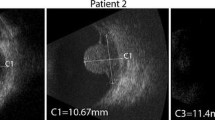Background and Purpose:
Proton therapy for uveal melanoma provides high-conformal dose application to the target volume and, thus, an optimal saving of the organs at risk nearby. Treatment planning is done with the model-based treatment-planning system EYEPLAN. Tumor reconstruction is based only on a fundus composite, which often leads to an overestimation of the clinical target volume (CTV). The purpose was to exploit MRI on trial in a proton therapy-planning system by using the novel image-based treatment-planning system OCTOPUS.
Patients and Methods:
Ten patients with uveal melanomas received both a high-resolution planning CT and MRI of the eye. MR examinations were made with an eye coil. EYEPLAN requires eye geometry data for modeling, and tantalum marker clips for submillimeter positioning and additional information from ultrasound and 3-D imaging. By contrast, OCTOPUS provides the full integration of 3-D imaging (e. g., CT, MRI). CTVs were delineated in each slice. For all patients, CTVs (EYEPLAN vs. OCTOPUS) were compared intraindividually.
Results:
OCTOPUS planning led to a mean reduction of the target volume by a factor of 1.7 (T1-weighted [T1w]) and 2.2 (T2w) without compromising safety. The corresponding field size could be scaled down on average by a factor of 1.2 (T1w) and 1.4 (T2w), respectively.
Conclusion:
Compared with the conventional EYEPLAN, MRI-based treatment planning of ocular tumors with OCTOPUS could be a powerful tool for reducing the CTV and, consequently, the treatment volume and the field size. This might be translated into a better patient compliance during treatment and a decreased late toxicity.
Hintergrund und Ziel:
Mit der Protonentherapie ist man bei Aderhautmelanomen in der Lage, das Zielvolumen mit hohen Dosen zu belegen und benachbarte Risikoorgane zu schonen. Bei Verwendung des modellbasierten EYEPLAN-Systems führt die Rekonstruktion anhand der Fundusdaten in den meisten Fällen zu einer Überschätzung des klinischen Zielvolumens (CTV). Ziel dieser Studie war es, mit Hilfe des neuen Bestrahlungsplanungssystems OCTOPUS Bestrahlungsplanungen MRT-basiert durchzuführen und mit der konventionellen Planung zu vergleichen.
Patienten und Methodik:
Zehn Patienten mit Aderhautmelanomen erhielten ein hochauflösendes CT sowie T1- (T1w) und T2-gewichtete (T2w) MRT-Untersuchungen des Auges. Für die Bestrahlungsplanung mit EYEPLAN wurden ein Fundusfoto und Tantalplättchen als Landmarken für die genaue Positionierung des Auges benötigt sowie Informationen aus Ultraschallmessungen und den klinischen 3-D-Bilddatensätzen (CT und MRT) hinzugezogen. OCTOPUS bietet die Möglichkeit, 3-D-Datensätze (CT, MRT) in den Planungsprozess zu integrieren. Das CTV wurde für OCTOPUS und EYEPLAN generiert und für beide Verfahren intraindividuell verglichen.
Ergebnisse:
Mittels OCTOPUS konnte eine mittlere Reduktion des Zielvolumens um den Faktor 1,7 (T1w) und 2,2 (T2w) erreicht werden, ohne die Therapiesicherheit zu beeinträchtigen. Die Feldgröße konnte im Mittel um den Faktor 1,2 (T1w) bzw. 1,4 (T2w) im Vergleich zu den jeweiligen Werten aus EYEPLAN verkleinert werden.
Schlussfolgerung:
Verglichen mit dem standardmäßig verwendeten EYEPLAN ist die MRT-basierte Bestrahlungsplanung mit OCTOPUS geeignet, reduzierte CTV, folglich auch reduzierte bestrahlte Volumina und besser an den Tumor angepasste Feldgrößen zu erzeugen. Die resultierende reduzierte Spättoxizität an den kritischen Strukturen gilt es nachzuweisen.
Similar content being viewed by others
Author information
Authors and Affiliations
Corresponding author
Rights and permissions
About this article
Cite this article
Marnitz, S., Cordini, D., Bendl, R. et al. Proton Therapy of Uveal Melanomas. Strahlenther Onkol 182, 395–399 (2006). https://doi.org/10.1007/s00066-006-1512-1
Received:
Revised:
Issue Date:
DOI: https://doi.org/10.1007/s00066-006-1512-1




